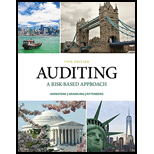
UTSTARCOM, INC.
(LO 2, 3, 4, 5, 6, 8)
UTStarcom is a global leader in the manufacture, integration, and support of networking and telecommunications systems. The company sells broadband wireless products and a line of handset equipment to operators in emerging and established telecommunications markets worldwide. The following excerpt was obtained from the 2004 10-K of UTStarcom. Inc., which reported material weaknesses in the company’s internal controls. In describing the company’s remediation efforts, the company stated that “planned remediation measures are intended to address material weaknesses related to revenue and deferred revenue accounts and associated cost of sales.”
These material weaknesses were evidenced by the identification of six separate transactions aggregating approximately $5 million in which revenue was initially included in the company’s fourth-quarter 2004 financial statements before all criteria for revenue recognition were met. In addition, there were other transactions for which there was insufficient initial documentation for revenue recognition purposes but which did not result in any adjustments to the company’s fourth-quarter 2004 financial statements. If unremediated, these material weaknesses have the potential of misstating revenue in future financial periods. The company’s planned remediation measures include the following:
- “The Company plans to design a contract review process in China requiring financial and legal staff to provide input during the contract negotiation process to ensure timely identification and accurate accounting treatment of nonstandard contracts.”
- “In March 2005, the Company conducted a training seminar regarding revenue recognition, including identification of nonstandard contracts, in the United States and, in April 2005, the Company conducted a similar seminar in China. Starting in May 2005, the Company plans to conduct additional training seminars in various international locations regarding revenue recognition and the identification of nonstandard contracts.”
- “At the end of 2004, the Company began requiring centralized retention of documentation evidencing proof of delivery and final acceptance for revenue recognition purposes.”
b. Using the previous disclosures as a starting point, identify challenges regarding internal controls that a company may face in doing business internationally.
c. The company had disclosed its planned remediation efforts for 2004. How might the auditor have used that information in planning the 2005 audit?
d. Considering potential analytical procedures relevant to the revenue cycle, identify analytics that the auditor might use in 2005 to provide evidence that the problems detected in 2004 have been remedied.
e. Considering potential substantive tests of revenue, identify procedures that might be applied in 2005 to provide evidence that the problems detected in 2004 have been remedied.
Want to see the full answer?
Check out a sample textbook solution
Chapter 9 Solutions
Auditing: A Risk Based-Approach (MindTap Course List)
- Green Co. incurs a cost of $15 per pound to produce Product X, which it sells for $26 per pound. The company can further process Product X to produce Product Y. Product Y would sell for $30 per pound and would require an additional cost of $10 per pound to be produced. The differential cost of producing Product Y is: a. $15 per pound b. $26 per pound c. $30 per pound d. $10 per poundarrow_forwardFinancial Accountingarrow_forwardWhen a company pays cash for a truck, what is the effect on the accounting equation for that company? A. Increase assets and increase liabilities. B. Decrease assets and decrease liabilities. C. Increase assets and increase equity. D. No net change.arrow_forward
- NO WRONG ANSWERarrow_forwardBaltimore Company experienced an increase in total assets of $12,500 during the current year. During the same time period, total liabilities increased $9,100. Shareholders made no investments during the and no dividends were paid. How much was Baltimore's net income? yeararrow_forwardWhich of the following statements are true with regard to asset accounts? a. Assets are on the left side of the accounting equation. b. Assets are the right-side of the accounting equation. c. Assets are increased with debits Assets are increased with credits. d. Assets are decreased with debits Assets are decreased with credits.arrow_forward
 Auditing: A Risk Based-Approach (MindTap Course L...AccountingISBN:9781337619455Author:Karla M Johnstone, Audrey A. Gramling, Larry E. RittenbergPublisher:Cengage Learning
Auditing: A Risk Based-Approach (MindTap Course L...AccountingISBN:9781337619455Author:Karla M Johnstone, Audrey A. Gramling, Larry E. RittenbergPublisher:Cengage Learning Accounting Information SystemsAccountingISBN:9781337619202Author:Hall, James A.Publisher:Cengage Learning,
Accounting Information SystemsAccountingISBN:9781337619202Author:Hall, James A.Publisher:Cengage Learning,- Principles of Accounting Volume 1AccountingISBN:9781947172685Author:OpenStaxPublisher:OpenStax College



